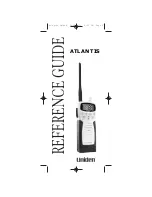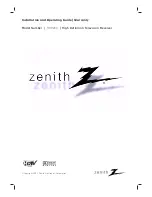
Page 18 of 90
CCT24
The other factor impacting latency is retries. This impact is not unique to frequency hopping radios but is
common among all wireless technologies. A radio only transmits data once per hop. It needs to wait until
the next hop to see if the transmission was received at the destination. If not, the radio will transmit the
data again and wait for the acknowledgement. This can happen up to
ARQAttemptLimit
number of times
which is equal to
ARQAttemptLimit
times
HopDuration
amount of time.
2.11.5 Configuration Validation
Although slot durations are automatically calculated by the CCT24, the RF data rate, hop duration, etc.,
must be coordinated by the user to assure a valid operating configuration based on the following criteria:
1.
Regardless of the RF data rate, the maximum CCT24 hop duration is limited to 200 ms. A CCT24
network must be configured accordingly.
2.
In protocol mode, the
BaseSlotSize
and
RemoteSlotSize
parameters must be large enough to
hold all the data bytes in the largest protocol formatted message being used. Protocol formatted
messages must be sent in a single transmission. Any protocol formatted messages too large for
the slot size setting will be discarded
3.
In TDMA mode 2, the
RemoteSlotSize
will be reduced automatically when a new remote joins the
network. This can cause a network to suddenly malfunction if the hop duration is not set to pro-
vide an adequately large remote slot allocation when fully loaded with remotes
4.
When operating in polling mode 0, the
CSMA_RemtSlotSize
and
HopDuration
parameters are
usually set to accommodate the number of data bytes in a maximum size transmission. This con-
figuration provides low latency for polled messages.
5.
When operating in CSMA mode 1 with multiple remotes, the
CSMA_RemtSlotSize
and
HopDura-
tion
parameters are usually set to accommodate three times the number of data bytes in one
maximum size transmission, to allow time for more than one remote to attempt to transmit during
a single hop.
The
DNT Throughput Calculator
utility program is shown in Figure 2.11.5.1. Decimal data is entered by
default. Hexadecimal data can also be entered using a 0x prefix, as shown in the
Hop Duration Counts
text box. When using the
DNT Throughput Calculator
, parameter coordination depends on the operating
mode of a CCT24 network, as outlined below:
Polling (mode 0) - the user can set and must coordinate the RF data rate, hop duration, base slot size
and remote slot size. First, set the
BaseSlotSize
to accommodate the maximum number of data bytes in a
base transmission. Next, set the
CSMA_RemtSlotSize
to accommodate the maximum number data bytes
in a remote transmission. Use these slot sizes, the RF data rate and the maximum operating range (20
miles is the default) as inputs to the
Calculator
program to determine minimum valid
HopDuration
.
CSMA contention (mode 1) - the same procedure as for polling is used, except that the
CSMA_
RemtSlotSize
typically should be set at three times the maximum number of data bytes for point-to-
multipoint networks. The default values for CSMA pre-delay and back-off are assumed.
TDMA dynamic (mode 2) - this is the CCT24’s default operating mode and the default settings are opti-
mized for point-to-point transparent operation. For other configurations the user must coordinate the RF
















































